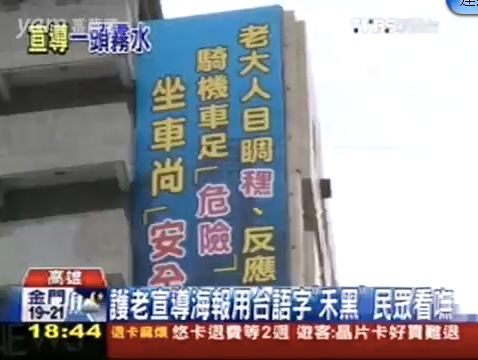Difficult Taiwanese characters
« previous post | next post »
[This is a guest post by Michael Cannings]
This brief news segment features a poster with a lot of interesting points packed into three short lines of text. The billboard is a traffic safety announcement by police in Kaohsiung, southern Taiwan.

[Screengrab with most of the text visible]
The word in focus in the report is bái (the reporter says it correctly, but the written romanization they give is wrong). The character used combines 禾 and 黑 into 䆀, which is part of Unicode and apparently pronounced měi in Mandarin, but it's not available through any of the Mandarin input methods on my computer. As shown in the report, some passersby can't identify the character, and I can't say I blame them. It is used for bái in the Ministry of Education Taiwanese dictionary and some other sources, and can be reproduced using the FHL input method for Taiwanese, but knowledge of the character is, as demonstrated by the vox pops, limited. For those trying to puzzle out the character from first principles there's no phonetic help as the elements are pronounced hô and o͘
Here's the text of the banner:
老大人目睭䆀、反應慢
騎機車足「危險」
坐車尚「安全」
Taiwanese pronunciation (in POJ romanization):
Lāu-tōa-lâng ba̍k-chiu bái, hóan-èng bān
Khiâ ki-chhia khah gûi-hiám
Chē-chhia siōng an-chôan
Rough translation:
Older people have poor eyesight and slow reactions,
Riding a motorbike becomes dangerous,
Riding in a car is safest.
For ease of comprehension it might have been better to replace 䆀 with a Mandarin phonetic loan like 敗 bài, a nonce character like [口敗], MPS (Zhuyin), or even a Taiwanese version of MPS (TPS). In MPS ㄅㄞˋ would get the point across, although the initial ㄅ (Pinyin: b; IPA: p) is not the same sound as in the Taiwanese word. Taiwanese has the initials b, p, and pʰ (written b, p, and ph in POJ), whereas Mandarin just has p and pʰ (written b and p in Pinyin). Taiwanese Phonetic Symbols, an adaptation of MPS, adds a character to represent Taiwanese b, which looks like ㄅ with a small circle at the bottom of the character rather than a hooked stroke. As this character isn't included in most Chinese fonts, here's an image of the word in TPS:

Any one of the above four methods would likely increase comprehension over using 䆀.
As the reporter also notes, most people have no problem with the character immediately above, 睭, reading it as chiu in the word ba̍k-chiu (eye). So this example combines a Taiwanese character people do understand with one they don't. Also in the second line there's 足, which I take to be khah. It's a multipurpose word which doesn't map easily to a single English definition, so I'll quote the Maryknoll Taiwanese–English Dictionary entry for it:
khah comparative particle. The meaning of this particle is usually given as "more", but in translating this word into English we very often must use a circumlocution on account of its idiomatic use. The chief reason for this is that it is joined not only to adjectives and adverbs to form the comparative degree, but it is also joined to verbs.
The character 足 is functioning as a two-stage loan – first a semantic loan from Mandarin zú "foot" to the etymologically unconnected kha "foot", and then a sound loan from kha "foot" to khah "more". One last notable feature: in the last line 尚 is used for siōng instead of the more usual Taiwanese 上 "most, -est, superlative modifier".
So within three lines we have four words that would likely flummox non-Taiwanese speakers: 目睭, 足, 尚, and 䆀; and the last one troubles even some native speakers.
Terence said,
November 9, 2015 @ 2:47 am
I have a Taiwanese friend with the nickname a-bái. He says he was given the nickname as he was an ugly baby. He usually writes this as 阿醜.
足 is actually tsiok meaning 很. I think most young kids would recognise this and the bái character due to the limited Taiwanese language classes they have in school, which features books including the standard characters released by the MOE.
Michael Cannings said,
November 9, 2015 @ 4:56 am
Ah, you're right. 足 is probably supposed to be chiok (sorry, POJ user here). Well spotted! In my defence, I have seen a lot of characters used for khah.
Speaking of nicknames, my in-laws call me A-pûi from time to time. Harsh.
minus273 said,
November 9, 2015 @ 11:31 am
Khah is usually 卡 or 較, I think.